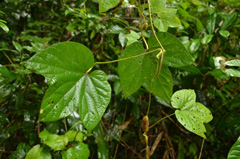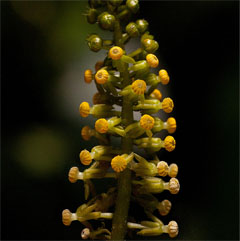 |
|
https://edibleplants.org/ |
 |
| https://edibleplants.org/ |
Translate this page:
Summary
Serendipity Berry or Dioscoreophyllum cumminsii is a perennial climbing plant about 1.8 m long with more or less woody stems that are usually 2cm in diameter and twines into other plants for support. It is native to tropical Africa. It is harvested from the wild for its edible fruit and root. The small, sub-ovoid fruit is a drupe that can be consumed raw ? it has mucilaginous pulp that is considered to be the sweetest known naturally occurring substance. The root, on the other hand, is small and yam-like and can be eaten like potatoes. Further, it is considered a sexual stimulant and used to cure wounds. The stem can be used on swollen limbs and as a wash against venereal diseases.
Physical Characteristics

 Dioscoreophyllum cumminsii is an evergreen Climber growing to 1.8 m (6ft) by 0.2 m (0ft 8in) at a medium rate.
Dioscoreophyllum cumminsii is an evergreen Climber growing to 1.8 m (6ft) by 0.2 m (0ft 8in) at a medium rate.
See above for USDA hardiness. It is hardy to UK zone 10.
Suitable for: light (sandy), medium (loamy) and heavy (clay) soils and prefers well-drained soil. Suitable pH: mildly acid and neutral soils. It can grow in full shade (deep woodland) or semi-shade (light woodland). It prefers moist soil.
UK Hardiness Map
US Hardiness Map
Synonyms
Rhopalandria cumminsii Stapf, Rhopalandria lobata C.H.Wright, Dioscoreophyllum jollyanum Pierre ex D
Plant Habitats
Edible Uses
Edible Parts: Fruit Root
Edible Uses: Sweetener
Fruit - raw. The intensely sweet, mucilaginous pulp of the fruit is considered to be the sweetest known naturally occurring substance - it is up to 3,000 times sweeter than sucrose[ 301 ]. It has been recommended as a non-carbohydrate sugar substitute[ 301 ]. The fruit can keep for several weeks at room temperature[ 301 ]. Roots. Small and yam-like[ 301 ].
References More on Edible Uses
Medicinal Uses
Plants For A Future can not take any responsibility for any adverse effects from the use of plants. Always seek advice from a professional before using a plant medicinally.
The fruit contains monellin, an intensely sweet protein with potential use as a sugar replacement for diabetics. For humans, monellin is 100,000 times sweeter than sucrose on a molar basis and around 3,000 times on a weight basis.
References More on Medicinal Uses
The Bookshop: Edible Plant Books
Our Latest books on Perennial Plants For Food Forests and Permaculture Gardens in paperback or digital formats.

Edible Tropical Plants
Food Forest Plants for Hotter Conditions: 250+ Plants For Tropical Food Forests & Permaculture Gardens.
More

Edible Temperate Plants
Plants for Your Food Forest: 500 Plants for Temperate Food Forests & Permaculture Gardens.
More

More Books
PFAF have eight books available in paperback and digital formats. Browse the shop for more information.
Shop Now
Other Uses
References More on Other Uses
Cultivation details
A tropical dioecious rainforest vine with tuberous underground stems. The fruit can be stored. It will keep for several weeks at room temperature.
References Carbon Farming Information and Carbon Sequestration Information
Temperature Converter
Type a value in the Celsius field to convert the value to Fahrenheit:
Fahrenheit:
The PFAF Bookshop
Plants For A Future have a number of books available in paperback and digital form. Book titles include Edible Plants, Edible Perennials, Edible Trees,Edible Shrubs, Woodland Gardening, and Temperate Food Forest Plants. Our new book is Food Forest Plants For Hotter Conditions (Tropical and Sub-Tropical).
Shop Now
Plant Propagation
Plants can be grown from seed or tubers. Seeds need to germinate in the dark. Plants can be grown from stem cuttings.
Other Names
If available other names are mentioned here
Ito-igbin, Minbagem Ngbi,
Native Range
AFRICA: Sudan, Central African Republic, Cameroon, Democratic Republic of the Congo, Gabon, Côte D Ivoire, Ghana, Guinea, Liberia, Nigeria, Sierra Leone, Togo.
Weed Potential
Right plant wrong place. We are currently updating this section.
Please note that a plant may be invasive in one area but may not in your area so it's worth checking.
Conservation Status
IUCN Red List of Threatened Plants Status : This taxon has not yet been assessed.

Growth: S = slow M = medium F = fast. Soil: L = light (sandy) M = medium H = heavy (clay). pH: A = acid N = neutral B = basic (alkaline). Shade: F = full shade S = semi-shade N = no shade. Moisture: D = dry M = Moist We = wet Wa = water.
Now available:
Food Forest Plants for Mediterranean Conditions
350+ Perennial Plants For Mediterranean and Drier Food Forests and Permaculture Gardens.
[Paperback and eBook]
This is the third in Plants For A Future's series of plant guides for food forests tailored to
specific climate zones. Following volumes on temperate and tropical ecosystems, this book focuses
on species suited to Mediterranean conditions—regions with hot, dry summers and cool, wet winters,
often facing the added challenge of climate change.
Read More
Expert comment
Author
(Stapf) Diels
Botanical References
Links / References
For a list of references used on this page please go here
A special thanks to Ken Fern for some of the information used on this page.
Readers comment
| Add a comment |
|
If you have important information about this plant that may help other users please add a comment or link below. Only comments or links that are felt to be directly relevant to a plant will be included. If you think a comment/link or information contained on this page is inaccurate or misleading we would welcome your feedback at [email protected]. If you have questions about a plant please use the Forum on this website as we do not have the resources to answer questions ourselves.
* Please note: the comments by website users are not necessarily those held by PFAF and may give misleading or inaccurate information.
To leave a comment please Register or login here All comments need to be approved so will not appear immediately.
|
Subject : Dioscoreophyllum cumminsii
|
|
|
|